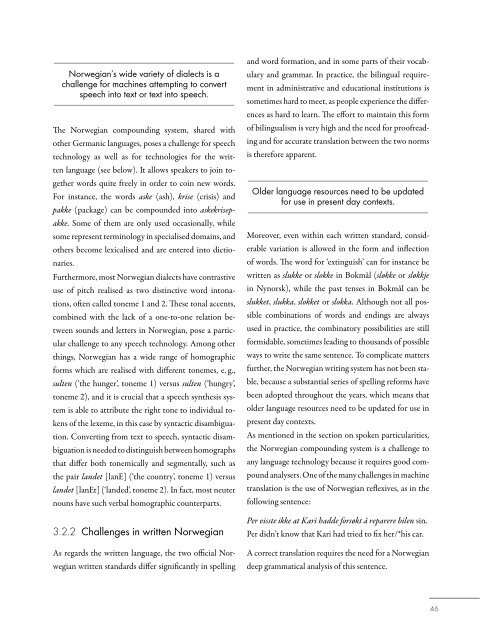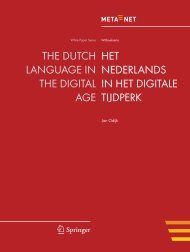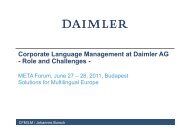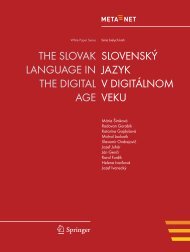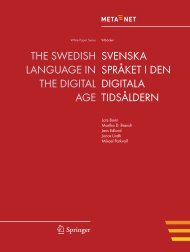Norsk i den digitale tidsalderen - Meta-Net
Norsk i den digitale tidsalderen - Meta-Net
Norsk i den digitale tidsalderen - Meta-Net
Create successful ePaper yourself
Turn your PDF publications into a flip-book with our unique Google optimized e-Paper software.
Norwegian’s wide variety of dialects is a<br />
challenge for machines attempting to convert<br />
speech into text or text into speech.<br />
e Norwegian compounding system, shared with<br />
other Germanic languages, poses a challenge for speech<br />
technology as well as for technologies for the writ-<br />
ten language (see below). It allows speakers to join to-<br />
gether words quite freely in order to coin new words.<br />
For instance, the words aske (ash), krise (crisis) and<br />
pakke (package) can be compounded into askekrisep-<br />
akke. Some of them are only used occasionally, while<br />
some represent terminology in specialised domains, and<br />
others become lexicalised and are entered into dictio-<br />
naries.<br />
Furthermore, most Norwegian dialects have contrastive<br />
use of pitch realised as two distinctive word intona-<br />
tions, oen called toneme 1 and 2. ese tonal accents,<br />
combined with the lack of a one-to-one relation be-<br />
tween sounds and letters in Norwegian, pose a partic-<br />
ular challenge to any speech technology. Among other<br />
things, Norwegian has a wide range of homographic<br />
forms which are realised with different tonemes, e. g.,<br />
sulten (‘the hunger’, toneme 1) versus sulten (‘hungry’,<br />
toneme 2), and it is crucial that a speech synthesis sys-<br />
tem is able to attribute the right tone to individual to-<br />
kens of the lexeme, in this case by syntactic disambigua-<br />
tion. Converting from text to speech, syntactic disam-<br />
biguation is needed to distinguish between homographs<br />
that differ both tonemically and segmentally, such as<br />
the pair landet [lanE] (‘the country’, toneme 1) versus<br />
landet [lanEt] (‘landed’, toneme 2). In fact, most neuter<br />
nouns have such verbal homographic counterparts.<br />
3.2.2 Challenges in written Norwegian<br />
As regards the written language, the two official Nor-<br />
wegian written standards differ significantly in spelling<br />
and word formation, and in some parts of their vocab-<br />
ulary and grammar. In practice, the bilingual require-<br />
ment in administrative and educational institutions is<br />
sometimes hard to meet, as people experience the differ-<br />
ences as hard to learn. e effort to maintain this form<br />
of bilingualism is very high and the need for proofread-<br />
ing and for accurate translation between the two norms<br />
is therefore apparent.<br />
Older language resources need to be updated<br />
for use in present day contexts.<br />
Moreover, even within each written standard, consid-<br />
erable variation is allowed in the form and inflection<br />
of words. e word for ‘extinguish’ can for instance be<br />
written as slukke or slokke in Bokmål (sløkke or sløkkje<br />
in Nynorsk), while the past tenses in Bokmål can be<br />
slukket, slukka, slokket or slokka. Although not all pos-<br />
sible combinations of words and endings are always<br />
used in practice, the combinatory possibilities are still<br />
formidable, sometimes leading to thousands of possible<br />
ways to write the same sentence. To complicate matters<br />
further, the Norwegian writing system has not been sta-<br />
ble, because a substantial series of spelling reforms have<br />
been adopted throughout the years, which means that<br />
older language resources need to be updated for use in<br />
present day contexts.<br />
As mentioned in the section on spoken particularities,<br />
the Norwegian compounding system is a challenge to<br />
any language technology because it requires good com-<br />
pound analysers. One of the many challenges in machine<br />
translation is the use of Norwegian reflexives, as in the<br />
following sentence:<br />
Per visste ikke at Kari hadde forsøkt å reparere bilen sin.<br />
Per didn’t know that Kari had tried to fix her/*his car.<br />
A correct translation requires the need for a Norwegian<br />
deep grammatical analysis of this sentence.<br />
46


